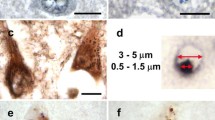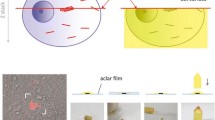Abstract
Immunolocalization of 14-3-3 proteins in Alzheimer’s disease (AD) brains was investigated using isoform-specific antibodies. Weak granular immunoreactivity of 14-3-3 proteins was found in neuronal cytoplasm in control subjects and AD brains. Both intracellular and extracellular neurofibrillary tangles (NFTs), as well as neuropil thread-like structures, were immunopositive for 14-3-3 proteins. This was corroborated by triple-fluorolabeling method visualizing paired helical filament (PHF) tau and 14-3-3 epitopes in relation to fibrillary state detected by thiazin red. Pretangle neurons (positive for PHF-tau without fibrillary structure detected by thiazin red) only contained fine granular immunoreactivity (IR) of 14-3-3, which was similarly found in unaffected neurons. Granular cytoplasmic IR of 14-3-3 proteins in pretangle neurons was not colocalized to granular tau-like IR, which suggests that participation of 14-3-3 proteins in NFT formation was restricted to its later stages. Its zeta isoform was most prominent in these NFTs, suggesting that this isoform is a major component involved in the formation of NFTs. In contrast, IR of epsilon isoform was found in the neuropil of the hippocampus and that of sigma isoform was localized to granule cells of the dentate gyrus in AD brains, as seen in the age-matched controls. Expression of 14-3-3 proteins were found to be highly variable and dependent on their isoforms, regions and cell types. Molecular, as well as topographical, dissection of 14-3-3 proteins will provide us with an improved understanding of this molecule in normal and pathological conditions.







Similar content being viewed by others
References
Agarwal-Mawal A, Qureshi HY, Cafferty PW, Yuan Z, Han D, Lin R, Paudel HK (2003) 14-3-3 connects glycogen synthase kinase-3β to tau within a brain microtubule-associated tau phosphorylation complex. J Biol Chem 278:12722–12728
Alyoman J, Das GD (1965) Autoradiographic and histological evidence of postnatal hippocampal neurogenesis in rats. J Comp Neurol 124:319–336
Aoki K, Uchihara T, Sanjo N, Nakamura A, Ikeda K, Tsuchiya K, Wakayama Y (2003) Increased expression of neuronal apolipoprptein E in human brain with cerebral infarction. Stroke 34:875–880
Baxter HC, Liu WG, Forster JL (2002) Immunolocalisation of 14-3-3 isoforms in normal and scrapie-infected murine brain. Neuroscience 109:5–14
Berg D, Holzmann C, Riess O (2003) 14-3-3 proteins in the nervous system. Nat Rev Neurosci 4:752–762
Boston PF, Jackspn P, Thompson RJ (1982) Human 14-3-3 protein: radioimmunoassay, tissue distribution, and cerebrospinal fluid levels in patients with neurological disorders. J Neurochem 38:1475–1482
Braak H, Braak A (1991) Neuropathological stageing of Alzfeimer-related changes. Acta Neuropathol 82:239–259
Fountoulakis M, Cairns N, Lubec G (1999) Increased levels of 14-3-3 gamma and epsilon proteins in brain of patients with Alzheimer’s disease and Down syndrome. J Neural Transm 57:323–335
Fu H, Subramanian RR, Masters SC (2000) 14-3-3 protains: structur, function, and regulation. Annu Rev Pharmacol Toxicol 40:617–647
Hashiguchi M, Sobue K, Paude HP (2000) 14-3-3 ζ is an effector of tau protein phosphorylation. J Biol Chem. 275:25247–25254
Hsich G, Kenney K, Gibbs CJ, Lee KH, Harrington MG (1996) The 14-3-3 protain in cerebrospinal fluid as a maker for transmissible spongiform encephalopathy. N Engl J Med 335:924–930
Ichihara T, Isobe T, Okuyama T, Yamauchi T, Fujisawa H (1987) Brain 14-3-3 protein is an activator protein that activates tryptophan 5-monooxygenase and tyrosine 3-monooxygenase in the presence of Ca2+, calmodulin-dependent protein kinase II. FEBS Lett 219:79–82
Iizima M, Tabira T, Poorkaj P, Schellenberg GD, Trojanowski JQ, Lee VM, Schmidt ML, Takahiashi K, Nabika T, Matsumoto T, Yamashita Y, Yoshioka S, Ishino H (1999) A distinct familial presenil dementia with a novel missense mutation in the tau gene. Neuroreport 25:497–501
Jones DH, Ley S, Aiken A (1995) Isoforms of 14-3-3 protein can form homo- and heterodimers in vitro: implications for function as adaptor proteins. FEBS Lett 368:55–58
Jones DH, Martin H, Madrazo J, Robinson KA, Nielson P, Roseboom PH, Patel Y, Howell SA, Aitken A (1995) Expression and structural analysis of 14-3-3 proteins. J Mol Biol 245:375–384
Kaplan MS, Bell DH (1984) Mitotic neuroblasts in the 9-day-old and 11-month-old rodent hippocampus. J Neurosci 4:1429–1441
Kawamoto Y, Akiguchi I, Nakamura S, Honjyo Y, Shibasaki H, Budka H (2002) 14-3-3 proteins in Lewy bodies in Parkinson disease and diffuse Lewy body disease brain. J Neuropathol Exp Neurol 61:245–253
Kawamoto Y, Akiguchi I, Nakamura S, Budka H (2002) Accumulation of 14-3-3 proteins in glial cytoplasmic inclusions in multiple system atrophy. Ann Neueol 52:722–731
Komori T Ishizawa K Arai N Hirose T Mizutani T Oda M (2003) Immunoexpression of 14-3-3 proteins in glial cytoplasmic inclusions of multiple system atrophy. Acta Neuropathol 103:66–70
Layfield R, Fergusson J, Aitken A, Lowe J, Landon L (1996) Neurofibrillary tangles of Alzheimer’s desease brain contain 14-3-3 protain. Neurosci Lett 209:57–60
Martin H, Rostas J, Patel Y, Aitken A (1994)Subcellular localisation of 14-3-3 isoforms in rat brain using specific antibodies. J Neurochem 63:2259–2265
Mercken M, Vandermeeren M, Lubke U, Six J, Boons J, Van de Voorde A, Martin J-J, Gheuens J (1992) Monoclonal antibodies with selective specificity for Alzheimer tau are direcred against phosphatase-sensitive epitope. Acta Neuropathol 84:265–272
Moore BW, Perez VJ (1967) In: Carlson FD (ed) Physiological and biochemical aspects of nervous integration. Prentice-Hall, New Jersey, pp 343–359
Murayama S, Nukina N, Ihara Y, Nakazato Y, Ishida Y, Takanashi R (1985) Immunocytochemistry of Pick’s argentophilic bodies: evidence for the involvement of high molecular weight microtubule-associated proteins (HMWP) before the appearance of tubulin (in Japanese). Rinsho Shinkeigaku 25:80–87
Muslin AJ, Tanner JW, Allen PM, Shaw AS (1996) Interaction of 14-3-3 with signaling proteins is mediated by the recognition of phosphoserine. Cell 84:889–897
Resch JF, Lehr GS, Wischik CM (1991) Design and synthesis of a potential affinity cleaving reagent for beta-pleated sheet protein structures. Bioorg Med Chem Lett 1:519–522
Richard M, Biacabe A-G, Streichnberger N, Ironside JW, Mohr M, Kopp Nicolas, Perret-Liauded A (2003) Immunohistochemical localization of 14-3-3ζprotein in amyloid plaques in human spongiform encephalopathies. Acta Neuropathol 105:296–302
Rosenquist M (2003) 14-3-3 proteins in apoptpsis. Braz J Med Biol Res 36:403–408
Satoh J, Kurohara K, Yukitake M, Kroda Y (1999) The 14-3-3 protain detectable in the cerebraospinal fluid of patients with prion-unrelated neurological diseases is expressed constitutively in neuronal and glial cells in culture. Eur Neurol 41:216–225
Skoulakis EMC, Davis RL (1998) 14-3-3 protains in neuronal development and function. Mol Neurobiol 16:269–284
Tzivion G, Avruch J (2001) 14-3-3 proteins: active cofactors in cellular regulation by serine/threonine phosphorylation. J Biol Chem 14:3061–3064
Uchihara T, Nakamura A, Yamazaki M, Mori O (2000) Tau-positive neurons in corticobasal degeneration and Alzheimer disease-distinction by thiazin red and silver impregnations. Acta Neuropathol 100:385–389
Uchihara T, Nakamura A, Yamazaki M, Mori O (2001) Evolution from pretangle neurons to neurofibrillary tangles monitored by thiazin red combined with Gallyas method and double immunofluorescence. Acta Neuropathol 101:535–539
Uchihara T, Nakamura A, Yamazaki M, Mori O, Ikeda K, Tsuchiya K (2001) Different conformation of neuronal tau deposits distinguished by double immunofluorescence with AT8 and thiazin red and combined with Gallyas method. Acta Neuropathol 102:462–466
Uchihara T, Ikeda K, Tsuchiya K (2003) Pick body disease and Pick syndrome. Neuropathology 23:318-326
Wakabayashi H, Yano M, Tachikawa N, Oka S, Maeda M, Kido H (2001) Increased concentration of 14-3-3 epsilon, gamma, and zeta isofrms in cerebrospinal fluid of AIDS patients with neuronal destruction. Clin Chim Acta 312:97–105
Zha J, Harada H, Yang E, Jockel J, Korsmeyer SJ (1996) Serine phosphorylation of death agonist BAD in response to survival factor results in binding to 14-3-3 not BCL-X(L). Cell 87:619–692
Acknowledgement
This work is supported in part by grants for Sumitimo Welfare Foundation.
Author information
Authors and Affiliations
Corresponding author
Rights and permissions
About this article
Cite this article
Umahara, T., Uchihara, T., Tsuchiya, K. et al. 14-3-3 proteins and zeta isoform containing neurofibrillary tangles in patients with Alzheimer’s disease. Acta Neuropathol 108, 279–286 (2004). https://doi.org/10.1007/s00401-004-0885-4
Received:
Revised:
Accepted:
Published:
Issue Date:
DOI: https://doi.org/10.1007/s00401-004-0885-4




